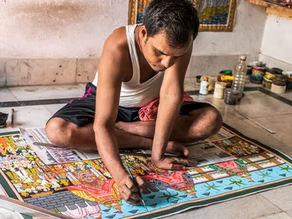Sillerygaon- The Hills That Beckon a Traveler

The mystical hamlet of Sillerygaon A small hamlet, perched at an altitude of 6000ft and surrounded by lush green mountains on all sides. The pine trees stand there like a royal guard protecting its hidden gems. The majestic Kanchenjungha can be viewed at a distance if the sky stands clear. The cool and misty air weaves around the village covering it in a cloak of peace and tranquillity. Sillerygaon, one of the picturesque destinations, is situated in the lap of the Eastern Himalayas in West Bengal’s Kalimpong district. Sillerygaon is one of those rare places which has managed to retain its beauty even in the 21st century. A village where time stands still, and where the sky speaks of bounty is a little haven for everyone wanting to get far away from the hustle-bustle of their daily life. With only some 30-35 families living here, Sillerygaon is the ideal place for an offbeat trip to the hills. With the ever-smiling locals, the children basking in the sun, and cinchona trees being a constant sight, Sillerygaon has a raw appeal that is best appreciated by travelers who have luckily chanced upon this hidden gem. Innocence and smiles in the lap of Sillerygaon A single and unpaved road snakes around the village while colorful matchbox-like houses rest on both sides of it. Sounds of the forest and birds can be heard almost all day as the cool breeze carries them to every house. No place for any luxurious hotel or a star restaurant, the houses have turned themselves into homestays offering a rare glimpse into the lifestyle and the local way of living. Sillerygaon remains unperturbed and undisturbed from the mechanization that has gripped the world. The Story Behind Sillerygaon Homestays of Sillerygaon If you go to Sillerygaon, you will see a forest of trees in the background. Those are the Sillery trees, unique to the region from which the hamlet has derived its name. Another common sight throughout the village is the cinchona plants which act as a source of the life-saving medicine, quinine. Initially, Sillerygaon was unaccustomed to tourists and travelers. However, the Silk route trip slowly gained popularity and Sillerygaon became the first place on the list in the Silk Route trip. Although the Silk Route tourists arrive at dusk and leave the next day at the crack of dawn, the real Sillerygaon can only be explored with 2-3 days at hand. As tourism saw a surge, the villagers saw a chance for economic upliftment and hence turned their homes into homestays, and thereby protecting their village from the onslaught of commercialization. Thus, in recent years, Sillerygaon has adopted the eco and organic lifestyle and offers travelers a rare chance to experience the same. With farm-fresh food, warm stories, starry nights, it has emerged as a postcard destination for fellow travelers. Wearing the Explorer’s Hat While Sillerygaon calls for a more relaxed way of traveling and adopting a laid-back lifestyle, there are still plenty of things to do. The village itself offers two treks, one that can take a few hours and the other that is relatively short and takes a maximum duration of 45 minutes. The first trek takes you to the nearby village of Ichhegaon while the short one takes you to Ramitey viewpoint, which offers a breath-taking view of the Teesta river. If you have some more days at hand, you can also hire a car and check out nearby attractions like the historic Damsang Fort, the Spiritual Hanuman Top, and Cross Hill. A visit to the town of Pedong and its local monastery can also be another beautiful addition to your stay at Sillerygaon. Travelers looking to stay longer can go and explore Kalimpong, some 18-20 km away and have a fun time exploring its monasteries, parks, churches, etc. In short, Sillerygaon has something for everyone. Below is the list of places you can visit while in Sillery Gaon- Ramitey View Point– Not only is the trek short and thrilling, it seems that once you reach the end, you are at the edge of the world. The unpaved path meanders through a jungle in the forest and stretches on for approximately 3 km. It is a relatively easy trek and suits a beginner fine. On the way, you will meet enthusiastic travelers heading towards the viewpoint. Ramitey viewpoint overlooks the 14 bends of the Teesta river, which also happens to be the longest view of Teesta, offering you a birds-eye view. It looks all the more glorious during the golden hour. Did you say mountains? Icche Gaon – A quaint little hamlet in the Kalimpong district, Icche Gaon which translates to the ‘wishing village’ is another destination that travelers can go to during their time at Sillery Gaon. A sister village to Sillery Gaon, Icche Gaon offers a majestic view of the Kanchenjunga and the surrounding ranges. Although the place can be reached through a trek from Sillery Gaon, it is advisable to take a car and go to the place. The distance by road from Sillery Gaon to Icche Gaon remains around 16 km. The wishing village will welcome you to its unspoiled beauty. The Wishing Village! Ramdhura– Another village that offers travelers an ideal gateway to nature and serenity, Ramdhura is situated some 15 km from Kalimpong and can be stopped for a break during the road between Kalimpong and Sillerygaon. A pristine and undisturbed location, Ramdhura is surrounded by pine trees and mountains on all sides. Sangchen Dorjee Monastery– Also known as the Pedong Monastery, this place of worship is hidden some 2 km away from the town of Pedong. The structure dates back to 1700 AD and houses relics of the Damsang Fort, the mummified body of the Bhutanese priest, Shabdrung Rinpoche, and also has frescoes relating to Tantric Buddhism. A peek into history, Sangchen Dorjee Monastery can be
Raghurajpur: Odisha’s best-kept secret

A village of chitrakars, in the land of God If Odisha is the best-kept secret of Incredible India, then Raghurajpur is of Odisha. A village where every villager is an artist, and every home, no less than an art gallery, Raghurajpur, is blessed with immense art and talent. The famous Pattachitra paintings root from here. An ancient village with quaint houses (120 approximately) surrounded by groves of coconut, mango, palm, and jackfruit, Raghurajpur may masquerade to be an ordinary hamlet but when you enter the village, you realize that you have entered an artists’ village where every settler is a chitrakar, painting foregone mythology and hailing Lord Jagannath. Hands that paint magic Read more about the travel experience from Odisha in the blog written by Parnashree!! How to reach? Only gaadi no ghoda! Situated 14km away from the abode of Lord Jagannath, a visit to Raghurajpur is a sine qua non if you happen to come to the pilgrimage town of Puri. Take the Bhubaneswar road from Puri and head towards Chandanpur on NH-316. Upon reaching the Chandanpur Bazaar, take a right turn to reach Raghurajpur, 1.5 km from Chandanpur, on the southern banks of river Bhargavi. You can take a local bus from Puri to Chandanpur and then take a long walk towards the village or book private means of transportation like auto or taxi for convenience. The nearest airport is Bhubaneswar and the nearest rail head is Puri. Village doesn’t have any stay options. Explore as a day trip from Puri. Jai Jagannath! Heritage of Raghurajpur Parampara, Pratishtha, Anushasan! It is believed that the village of Raghurajpur was established by the ruler of the Eastern Ganga Dynasty, King Narasingha Deva I. During the reign of the Eastern Ganga Dynasty, art and architecture flourished exponentially. In this period, Pattachitra art matured here and now as an ancestral treasure, the skill is passed from one generation to the other. Artists here trace their origin to the Savar tribe and are known as ‘chitrakars’. Lovebirds: Radha Krishna Pattachitra evolved from two Sanskrit words Patta (cloth) and Chitra (painting) is one of the oldest art forms of Odisha that dates back to the 5th century BCE. As the name suggests, Pattachitra was traditionally painted on cloth. There are various types of Pattachitra paintings- Tassar Pattachitra, Palm leaves Patta Chitra and lately, chitrakars have started painting on coconuts, betel nuts, clay pots, and bottles. Just saying bottles will be an understatement! The artists traditionally painted playing cards or Ganjifa. Another interesting piece of art you might find- Chitra pothies. They are a collection of painted palm leaves with mythological themes, stacked on top of each other and held together through a string. The preparation of canvas is an elaborate process. To make the surface hard yet absorbent, a gummy paste of boiled tamarind seeds and soft granite powder is plastered on the stretched piece of cloth. It is a tradition to directly paint the borders first and then apply flat colors which are normally white, black, yellow, red. The materials used in the paint are extracted from vegetables and mineral resources. For instance, black is made out of the shoot, white is prepared from crushed, boiled, and filtered shells and red shingle stone. Chitrakars paint mythological and folk themes. Krishna Leela and the portrayal of Lord Jagannath, Subhadra, and Balabhadra are major depictions. Shilpa Guru Dr.Jagannath Mahapatra, a prominent Pattachitra artist hailed from here. Still want to hang Tarzan in your car? Raghurajpur is a treasure of art and cultural heritage. It is here where Gotipua Nritya, the precursor of Indian classical dance, Odissi originated. Gotipua means single boy (goti-pua), is a traditional dance form with acrobatic elements, performed by a group of boys who dress as women to praise Lord Jagannath, Krishna, and Radha. However, the dancers are now breaking the conventional gender barriers. But in Raghurajpur, the tradition is still rigid. Abhinav Sundar Gotipua Dance Gurukul in the village is a voluntary institution in the residence of Guru Basant Kumar Maharana and founder Director Guru Sri Laxman Maharana. Replicating the ancient Gurukul system, the boys here stay with the Guru in his residence for at least six years to complete the course of training. The institution also provides formal education up to 10th grade. Raghurajpur is the birthplace of Odissi dancer Padma Vibhushan Guru Kelucharan Mohapatra and Gotipua dancer Padma Shri Guru Maguni Charan Das. Gotipua nritya (behind the scenes) Faith and festival Jai Jagannath! The village has a temple for its presiding deity, Goddess Bhuasuni, and a series of other temples devoted to gods like Radha Mohan, Gopinath, Raghunath, Laxminarayan, and Gouranga. Basant Utsav- Parampara Raghurajpur is an annual spring festival organized here in February or March and is a major tourist attraction. It was first organized in 1993 under the guidance of the State Tourism Department and Eastern Zonal Cultural Centre, Kolkata. Artists’ Village turned Heritage Village The world is here, where are you? INTACH in 2000 after a two-year intensive research and documentation developed it as a heritage village and the Odisha government declared it as one. When I first visited the place with my parents, I was too young to appreciate Odisha’s heritage of art and craft and comprehend its kernel. But their simplicity and warm welcome moved me. They didn’t force us to buy anything. They were extremely enthusiastic to show us their artwork. We did buy a painting but unfortunately, we couldn’t pay the price the painting was worth as we were short of money that day but they happily took whatever we paid and only asked to visit them more often! The diligence of the artists who despite all odds were passionate to take forward the legacy of Raghurajpur will impel you to spend more days in their harbor. The fine strokes of the artists, their incredible talent, and their zeal

